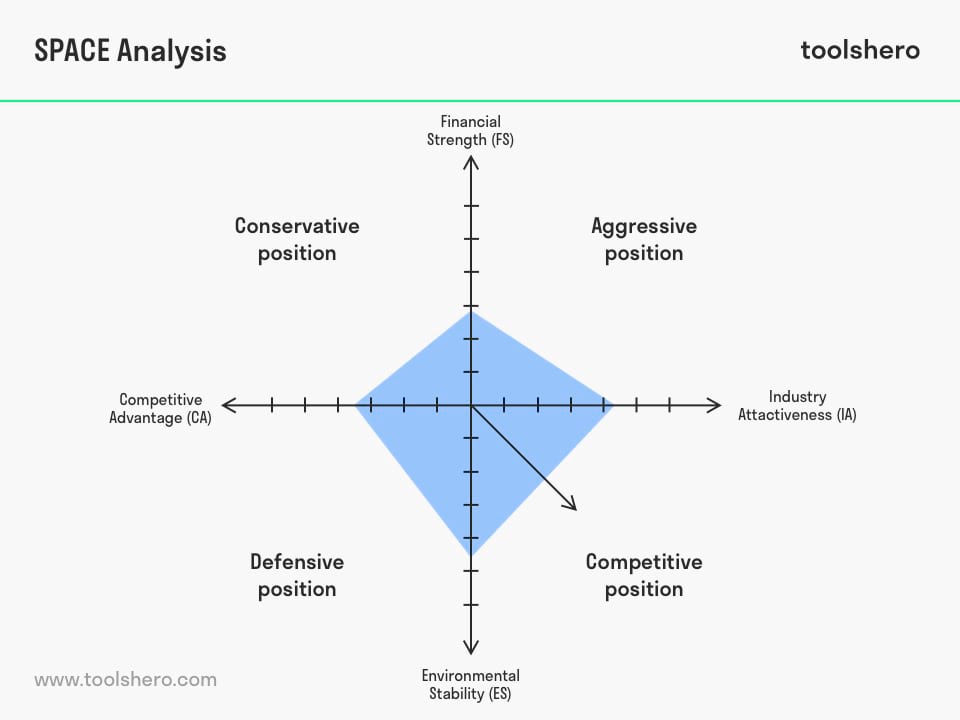SPACE Analysis, a strategy theory and tool

SPACE Analysis: this article explains the SPACE Analysis model in a practical way. Next to what it is, this article also highlights the importance of the organisation’s external environment,
the internal environment, the four positions within the matrix and the evaluation. After reading it, you understand the basics of this strategy tool. Enjoy reading!
What is the SPACE Analysis?
A SPACE Analysis makes it easier for upper management to make strategic choices and decisions and create a plan. SPACE is an acronym of Strategy, Position, Action, and Evaluation. Organisations’ external and internal environments play a major role in the SPACE Analysis.
In general, the analysis is represented in a matrix. The top of the Y-axis says ‘Financial Strength’ (FS), and the bottom of the Y-axis shows ‘Environmental Stability’ (ES).
The left of the X-axis shows the ‘Competitive Advantage’ (CA), and ‘Industry Attractiveness’ (IA) is shown on the right. Combined this leads to four positions; conservative, aggressive, defensive, and competitive.
The SPACE Analysis can then lead to creative ideas with an appropriate corporate strategy.

Figure 1- the SPACE Analysis model and matrix
SPACE Analysis, the External Environment
To start, the SPACE Analysis shows two criteria that describe the organisation’s external environment:
1. Environmental Stability (ES)
This is the environment’s stability that can be found on the low end of the Y-axis on the matrix. The stable environmental factors are influenced by a number of sub-factors. The bigger the impact, the higher on the Y-axis it is shown. Think of sub-factors, such as:
Technology
Technology changes rapidly and has a significant impact on organisations. In order to survive, businesses will have to adapt to new technologies.
Economy
One example is inflation, which refers to rising prices and money losing value and affecting businesses
Stock market
When the stock market fluctuates (volatility), it becomes more difficult for businesses to make larger investments
Competition
If competing protects are a lot cheaper, it’ll be hard for businesses to survive
Price elasticity
The stronger product demand responds to a price change, the harder it is for businesses to calculate a stable price
Substitutes
The easier it is to replace a product or service, the harder it is for businesses in that market to compete
2. Industry Attractiveness (IA)
To the right on the X-axis of the SPACE Analysis matrix, it shows the industry attractiveness. It indicates how attractive it is for businesses to operate in a certain sector. The higher the AI, the farther to the right it is on the X-axis. The following sub-factors could influence this external factor:
Growth potential
If there is certainty and a chance for growth by operating in a certain sector, companies would do well to take on this adventure
Profit potential
This is directly related to the growth potential; changes of increased profits make it a wise decision to focus on a certain sector
Financial stability
If entering a new market results in financial insecurity, it’s better for businesses to stay away
Complexity
The more complex getting into a certain sector is, the lower the chances of success. Some (foreign) sectors have strict regulations, and permits, for instance
Labour productivity
To what extent will entering a new market/sector create new jobs? The better the labour productivity, the more attractive the industry.
Business Startup Blueprint & Business Intelligence
SPACE Analysis, the Internal Environment
Like the external environment, the internal environment also consists of two criteria.
1. Competitive Advantage (CA)
The competitive advantage can be found on the left side of the X-axis of the SPACE Analysis. The bigger this advantage is, the farther left it moves. This can also be influenced by a number of factors, namely:
Market share
The larger the market share, the more has to be produced, which in turn affects the required resources, machines, and personnel
Product quality
If the quality of the products goes down, it will affect sales. That’s why it’s a good idea for businesses to always monitor their internal quality control process
Product life cycle
This is closely related to product quality; the longer a product lasts, the more reliable the consumer will think it is. This also relates to continuous quality monitoring
Innovation cycle
This also relates to quality. Companies that don’t innovate and don’t apply new technologies in their manufacturing, will fall behind and their products will be of lesser quality.
Customer loyalty
To make customers loyal, businesses will have to make concessions to those customers. They have to apply that what customers find important to their production
2. Financial Strength (FS)
The top of the SPACE Analysis matrix’s Y-axis shows the financial strength of the organisation. The stronger an organisation is financially, the higher its position on the Y-axis. Here too are a number of factors that influence this:
Returns
If companies make a lot of money from their investments, this will make them financially stronger
Liquidity
In addition to returns, it’s also important that there is enough available money, for instance to pay suppliers without delay
Debt level
The lower the debt level, the more financially stronger the business. Lots of loans and outstanding bills creates a higher debt level, negatively affecting financial strength
Inventory turnover
The higher the value of its stock, the stronger a company is financially.
However, it’s important that the inventory turnover ratio is high too, or there may be a risk of unsellable stock. The inventory turnover ratio is a good indication of the total value of the company’s inventory and speed at which it is sold
Four Positions within the SPACE Analysis matrix
In order to determine a strategy, you first have to find out the position of the organisation. Only then can you take actions that can be evaluated later.
There are four positions between the SPACE Analysis matrix’s Y-axis and X-axis. Each end represents a sub-factor to which a value can be assigned between 0 and 6; for CA and ES this is 0 to -6. The values of the individual factors are then noted on the axes in the matrix.
There where the surface area is largest because of the value of these factors, is where the best choice for a strategic plan will be. You can see the four strategic positions from the SPACE analysis below. P(osition) and AC(tion) are also considered:
Conservative strategy
The conservative strategy is located between the company’s financial strength and the competitive advantage. This is usually a stable organisation, with low growth.
The following actions would be potential options for a company in this position:
- Focus on existing successful products and cherish these
- Also leave room to develop new products
- Potential product penetration through expansion
Aggressive strategy
The aggressive strategy is located between financial strength and industry attractiveness. This is a stable organisation that actively chooses to compete with similar businesses.
The following actions would be potential options for a company in this position:
- Focus on products that can really compete with other businesses
- A focused marketing campaign to gain a larger market share
- Focus on offering the lowest price compared to competitors
- Look for potential companies to take over and increase the market share
Defensive strategy
The Defensive strategy of the SPACE Analysis is located between environmental stability and competitive advantage. These are businesses that are being pushed out by the competition. If they don’t take action, chances are they won’t make it.
The following actions would be potential options for a company in this position:
- Reduce costs to realise a stronger competitive position
- Reduce investments and manufacture at low cost
- Focus on core business and sell off ancillary activities
Competitive strategy
The competitive strategy of the SPACE Analysis is located between industry attractiveness and environmental stability. These are companies that are competitive but not stable.
The following actions would be potential options for a company in this position:
- Look for partnership opportunities with stable companies
- Increase productivity to make supply more reliable
- In addition to the core business, seek other products to boost sales
SPACE Analysis Evaluation
A company can only take action when the aforementioned position has been determined. Based on this position, they can consider the best choices for strategic management and which actions to take.
After no more than a year, progress should be evaluated by creating a new matrix and analysing it. If there are shifts, it’s important that upper management considers the pros and cons. If there is an upside, they can stick to their strategy.
However, if there is a downside, they must consider implementing changes.
Now it’s your turn
What do you think? Do you recognize the explanation of the SPACE Analysis? Does this model help your organisation to make strategic choices and decisions? Do you have any tips or comments?
Share your experience and knowledge in the comments box below.
More information
- Dess, G. G., & Miller, A. (1996). Strategic management (Vol. 2). McGraw-Hill.
- Porter, M. E., (1985). Creating and sustaining superior performance. Competitive advantage, 167.
- Radder, L., & Louw, L. (1998). The SPACE matrix: A tool for calibrating competition. Long range planning, 31(4), 549-559.
How to cite this article:
Mulder, P. (2019). SPACE Analysis. Retrieved [insert date] from Toolshero: https://www.toolshero.com/strategy/space-analysis/
Original publication date: 11/14/2019 | Last update: 12/22/2023
Add a link to this page on your website:
<a href=”https://www.toolshero.com/strategy/space-analysis/”>Toolshero: SPACE Analysis</a>












